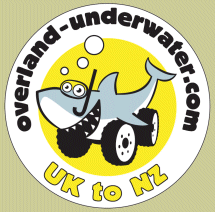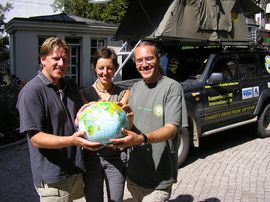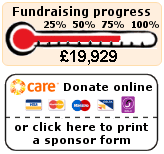| Final Statistics: Alex & Maz | Total distance: 93,550km |
| Furthest Point: Rotorua, NZ | Now settled in Sydney, Australia |
| Final Statistics: Martin | Total distance: 79,698km |
| Furthest Point: Hobart, Australia | Now settled in Bristol, UK |
New co-pilot signs on for duty...
Egypt, Country 12, Diary entry 3rd-7th Oct 2005, Total distance in Egypt: ~5000km
My "best and worst" list...
Thumbs up: Kelly kettle. This is a conical shaped kettle which holds a thin layer of water between its metal walls so when you light a fire in its base it heats the water very quickly. More convenient than setting up the stove and saves our gas supplies too. Need to strap twigs to the roof for those nights in the desert :) Pressure cooker. Also saves gas by cooking food quicker, but let's face it, it's the fact that the food gets into my gob that much sooner that really makes the difference. Will be invaluable later in the trip when we climb to higher altitudes to stop the tea tasting awful.
Thumbs down: Tyre valves. Two broken so far, so had the rest swapped to be sure. Subsequent false alarms, touch wood no more problems?
Upon awaking to find an extra person in the room (Alex had got up in the middle of the night to fetch Maz from the airport) we grabbed some breakfast and each set off towards our destination.
It was only a brief hello to Maz because we decided to go separate directions from this point... so from here this diary entry is only for me; the others have their own stories to tell! But we all decided to get out of Cairo because we had had enough of the traffic mayhem. Alex and Maz headed straight for Luxor (via the Toyota garage again) but I had a very important reason to head to Hurghada instead... to pick up my new co-pilot! If you read our entries from Turkey you might remember mention of a Russian girl called Elena that I met working on the dive boat in Kemer, well we decided that we both liked the idea of meeting up again (and she was interested in seeing what Egypt was like with a view to working there for a while) so she flew out to Egypt to join the expedition for a couple of weeks!
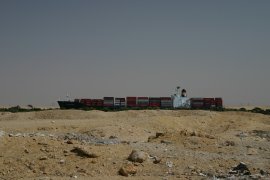 On the way from Cairo to Hurghada I decided to take a detour via Suez just because I wanted to see some big ships being threaded through the eye of a needle into the Suez Canal. Suez itself is, I discovered, a pretty ugly place made up of lots of docks and desert joining the docks together, but eventually I managed to find where the canal ought to be but unfortunately it's very difficult to get close enough to actually see it. I followed it along for about 20km trying to catch a glimpse but everywhere it seemed it might be possible to get close, there was a strong military presence telling me to go away. After once again having guns pointed at me I gave up, deciding that Hurghada was the safer place to be and continued my way south.
On the way from Cairo to Hurghada I decided to take a detour via Suez just because I wanted to see some big ships being threaded through the eye of a needle into the Suez Canal. Suez itself is, I discovered, a pretty ugly place made up of lots of docks and desert joining the docks together, but eventually I managed to find where the canal ought to be but unfortunately it's very difficult to get close enough to actually see it. I followed it along for about 20km trying to catch a glimpse but everywhere it seemed it might be possible to get close, there was a strong military presence telling me to go away. After once again having guns pointed at me I gave up, deciding that Hurghada was the safer place to be and continued my way south.
Arriving in Hurghada in the evening after a pleasant drive along the Red Sea coast, I decided first to find a hotel and parked near the souk in the Ad-Dahar area, which is the older part of the town, but immediately found myself mobbed by locals kindly offering me a look at their shop selling whatever tourist tat. If you want to buy a cheap-looking T-shirt with Tutankhamun's mask then there is much better choice here than in Cairo! I managed to dodge the traders without being too rude and moved a little away to a hotel on the edge of the madness recommended by Lonely Planet. Hurghada is so big and sprawling that there's no chance of camping there, but the hotel was clean and cheap so that was fine.
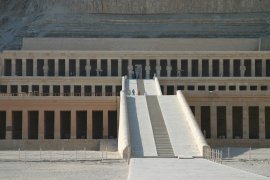 The next day I had the whole day to myself before Elena's flight landed in the evening so I decided to make good use of the time by taking a walk to the beach... which proved to be easier said than done. Even where the Lonely P map says there is a public beach, they are now building another resort on it so basically along the whole coast there is one resort after another with the occasional port, with no public sections that I could find. Rather disappointing, but then I guess I'm not your typical Hurghada tourist. So, emboldened by our prior success pretending we belonged at the Radisson in Aqaba, I strolled through the security controls at the front of one of the resorts and straight through the hotel building and out into their gardens and beach area. The sea in that area looks beautiful, you can see the turquoise of the coral reefs and deep blue between, though the beaches themselves are not great, especially the one I chose which had a real Butlin's holiday camp atmosphere with someone shouting in Italian over a public address system presumably making sure everyone's having enough fun. I didn't stay long.
The next day I had the whole day to myself before Elena's flight landed in the evening so I decided to make good use of the time by taking a walk to the beach... which proved to be easier said than done. Even where the Lonely P map says there is a public beach, they are now building another resort on it so basically along the whole coast there is one resort after another with the occasional port, with no public sections that I could find. Rather disappointing, but then I guess I'm not your typical Hurghada tourist. So, emboldened by our prior success pretending we belonged at the Radisson in Aqaba, I strolled through the security controls at the front of one of the resorts and straight through the hotel building and out into their gardens and beach area. The sea in that area looks beautiful, you can see the turquoise of the coral reefs and deep blue between, though the beaches themselves are not great, especially the one I chose which had a real Butlin's holiday camp atmosphere with someone shouting in Italian over a public address system presumably making sure everyone's having enough fun. I didn't stay long.
I then explored the Sigala region which is Hurghada's more up-market district and sat down for a cappuccino and a read of my book. This day was the first day of Ramadan so I thought it might not be possible to buy food and drink during daylight but being such a tourist place, Hurghada was still fully open and the only concession that I saw was one restaurant displaying a sign saying they were not serving alcohol during Ramadan. Hurghada was to prove the exception and it was much more difficult in other places, until we got into the routine.
Finally with Elena a mere few hours away from arrival I had the excuse I needed to go through everything in the car throwing away things I decided I wouldn't ever need, which took a surprisingly long time, and still there remained many things that "maybe one day" I would need, but at least at the end I had a clear passenger seat and now quite a lot of space behind for whatever mountains of stuff Elena decided to bring. Everything finished, I made my way to the airport and with a little confusion as to where exactly we should meet (it may be an international airport, but it's still Egypt!!) we met and made our way back to the town.
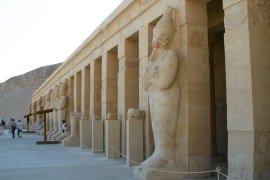 The next day after realising that I'd moved a lot of my stuff into the hotel room and that all had to go in the car somewhere, I found to my amazement that it would all fit (if squeezed a little) and we headed off towards Luxor to catch up with Alex and Maz.
The next day after realising that I'd moved a lot of my stuff into the hotel room and that all had to go in the car somewhere, I found to my amazement that it would all fit (if squeezed a little) and we headed off towards Luxor to catch up with Alex and Maz.
We followed the coast road for 60km to Safaga and then we hit our first obstacle - the police would not allow us to take the road across the desert towards the Nile! There are three convoys per day: 6am, 9am and 6pm and we arrived there at about 9:30am. Egyptians were merrily rolling past us as we tried to persuade them to let us through but they said we could go to the police station in town and ask if we wanted to. Faced with a wait of several hours and nothing better to do, we decided that we fancied the argument so we went in and spoke to increasingly more senior people ending up with the big boss. We know he was the big boss because his white uniform was actually white and even ironed! Unfortunately his only English seemed to be "6 o'clock", which didn't help too much. Well, actually, all policemen seem to know how to ask "nationality?" and with Elena being Russian it triggers all sorts of phone calls that the British answer doesn't. So we were stuck on the coast for another day, and Safaga being a tiny place with nothing to do, we headed back to Hurghada and killed the day there before returning in plenty of time for the 6pm convoy.
The convoy was a mysterious affair. It consisted of ourselves plus a few little minibuses with a couple of tourists in each, we eventually set off all together with our police escort, much more than half an hour late, of course (why wasn't the morning one late?!), and in our minds forming a much easier and better target for any potential terrorist attacks. The start of the road was quite pleasant through more desert mountains, including a forced refreshments stop at a restaurant, but then it got dark and it was a bit of a struggle for us to keep up with the convoy which cruised along at 100km/h - regardless of the road being straight, bendy or through the towns and villages along the Nile, the police having stopped all traffic in anticipation of our arrival but still rather too rapid for my 4 tonne lump of metal. We finally arrived at Luxor and the Rezeiky Camp where Alex and Maz had told us they were staying, and a well-earned feast was ordered there.
The next morning we all got up early and Alex and Maz continued on their way while Elena and I set off to see the sights of Thebes, which is the west bank of the Nile at Luxor where they used to put all their dead people. After following the directions given by the man at the camp site ("turn right then right and after 8km there's a bridge to cross the Nile") and deciding after about 15km past paddy fields and through villages with no sign of a bridge that maybe we should look at the map, we realised that the second right was actually a left and we'd gone completely the wrong way along the river. So we had to go past all the villagers who had already gawped at us first time through, and after this minor bonus sightseeing trip was finished we found the bridge and crossed to the west bank, past the Colossi of Memnon - two statues dedicated to Amenhotep III conveniently situated just on the side of the road - and on to the Valley of the Kings.
Turning up in a private vehicle has one major advantage over arriving by coach: the tat merchants are caught unawares and we managed to get past half of them before any of them noticed us and leapt up from their Ramadan snoozing to push their wares onto us. With even the keenest ones successfully fought off, we got to the ticket booth and took a little train (like le Petit Train de Chambery for those who know it) to the tombs. It was only a couple of hundred metres ride before arriving at the tombs which even in the searing heat wouldn't have been too hard... Sorry to any Americans reading, but it was for you lot and you know it :) The entrance ticket included entrance to any three tombs except Tutankhamun's, so following recommendations of the various guide books we had to hand (including several donated by my parents who were there in February) we chose Tuthmosis III (vainly situated 30m up the side of a cliff to deter tomb raiders), one built for Queen Tawroset and then commandeered by Sethnakht, and the third one for Siptah which is the longest, penetrating over 100m into the rock. All were different in style inside and in varying conditions but all were at one time very ornately decorated, and in some cases the paintwork there is extremely detailed and still vivid in colour despite being something like 5000 years old.
Also surprising was that all these kings and queens were buried in such a small area. I was expecting something much bigger and find it strange that Tutenkhamun's tomb, being in the middle of this small area, wasn't discovered and raided by tomb raiders long before Howard Carter discovered it in 1922. Lucky for us though!
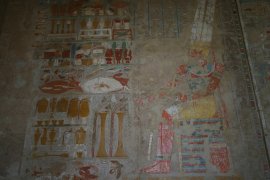 After the Valley of the Kings we went down the road to the Temple of Hatshepsut (or Hot Chicken Soup, as our guide in the Egyptian Museum in Cairo called her). This temple is the funerary temple of Queen Hatshepsut carved into a sheer cliff face in the next valley along from the kings' tombs. It has suffered two very unfortunate incidents, the first inflicted by her successor Tuthmosis III who for some reason didn't like her very much so desecrated and vandalised large parts of the temple, and the second more recently when militants massacred 58 tourists here in 1997 as part of a long-running feud between themselves and the police. Security in the whole Luxor region (and in fact Egypt as a whole) was high-profile but one of the guards leaving his Uzi unattended on a statue pedestal because he didn't have enough hands to hold it, smoke and scratch his bum all at the same time kind of ruined the effect a little.
After the Valley of the Kings we went down the road to the Temple of Hatshepsut (or Hot Chicken Soup, as our guide in the Egyptian Museum in Cairo called her). This temple is the funerary temple of Queen Hatshepsut carved into a sheer cliff face in the next valley along from the kings' tombs. It has suffered two very unfortunate incidents, the first inflicted by her successor Tuthmosis III who for some reason didn't like her very much so desecrated and vandalised large parts of the temple, and the second more recently when militants massacred 58 tourists here in 1997 as part of a long-running feud between themselves and the police. Security in the whole Luxor region (and in fact Egypt as a whole) was high-profile but one of the guards leaving his Uzi unattended on a statue pedestal because he didn't have enough hands to hold it, smoke and scratch his bum all at the same time kind of ruined the effect a little.
Fortunately Tuthmosis wasn't a very good vandal and still much of the temple is intact and well worth a visit. The top tier of the cake consists of a row of columns with a statue (or the remains of one) in front of each as guardians. Each statue is of the queen herself but represented as a male with ceremonial beard. Behind those is a courtyard and then the inner sanctum of the Temple of Amun (Amun being the king of the gods) which is unfortunately closed to the public. For us though, the carved murals on the lower level were particularly impressive with many of them intact and still brightly coloured with their original paintwork. Of course it hasn't been exposed to the elements for the thousands of years since it was painted, it was excavated much more recently than that. In fact to the side of the temple excavation works are underway where they've found some new old stuff to look at. Can't win on that one - excavate it and it'll be enjoyed for the time being but eventually it'll erode. Leave it where it is and it'll stay preserved but nobody gets to see it.
Finally we decided to call it a day and returned to the camp site for some more of the fantastic Egyptian food they had on offer there and a well-earned night's sleep.
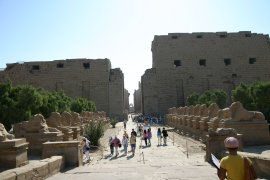 We got up early the next morning to visit the Temples of Karnak, and after going through exactly the same parking rigmarole as Alex and Maz had suffered two days before, with the exception of the bit at the end where they ask you to move a few metres and I pretended I couldn't understand and walked away, we got to the entrance along a sphinx-lined path and into the first courtyard.
We got up early the next morning to visit the Temples of Karnak, and after going through exactly the same parking rigmarole as Alex and Maz had suffered two days before, with the exception of the bit at the end where they ask you to move a few metres and I pretended I couldn't understand and walked away, we got to the entrance along a sphinx-lined path and into the first courtyard.
Actually Karnak is a group of different temples where one pharaoh added bits to what was already there, and as such was a work in progress for some 1500 years and covers 1.2 square kilometres. It takes a while to walk around, especially when snapping photos left right and centre, though I'd place a bet that I covered it quicker than Alex and Maz :) There are many great sights to be seen here including an imposing grantite statue of Ramses II and a large obelisk taken from the Aswan quarry but for me the highlight was the magnificent Great Hypostyle Hall. The hypostyles are large pillars ornately carved with hieroglyphics and flare at the top to represent giant papyrus, one of the symbols of Upper Egypt. There are 134 of them in the one hall and the resulting effect is rather like getting lost in a giant papyrus forest.
 Last stop in Luxor was the Mummification Museum where we got a lovely display of some of the gruesome tools of the trade along with various mummified stuff - not just people but all sorts of animals where you have to wonder what was the point - cat, goose, fish, dog etc. The cat was a sacred animal to the ancient Egyptians but mummifying a fish? Must have been a slippery job. The museum was interesting but quite small, so we had plenty of time for a spot of lunch before catching the convoy to Aswan at 3pm, but being Ramadan, everything in Luxor was shut! After a frustrating half an hour driving round looking for something I finally decided to head out to the Movenpick resort hotel we'd passed the previous day. There we managed to get some food and a nice view over the feluccas parked on the Nile while we ate, which we did slowly, until around 2pm when we thought we'd better get a move on rather than miss the convoy.
Last stop in Luxor was the Mummification Museum where we got a lovely display of some of the gruesome tools of the trade along with various mummified stuff - not just people but all sorts of animals where you have to wonder what was the point - cat, goose, fish, dog etc. The cat was a sacred animal to the ancient Egyptians but mummifying a fish? Must have been a slippery job. The museum was interesting but quite small, so we had plenty of time for a spot of lunch before catching the convoy to Aswan at 3pm, but being Ramadan, everything in Luxor was shut! After a frustrating half an hour driving round looking for something I finally decided to head out to the Movenpick resort hotel we'd passed the previous day. There we managed to get some food and a nice view over the feluccas parked on the Nile while we ate, which we did slowly, until around 2pm when we thought we'd better get a move on rather than miss the convoy.
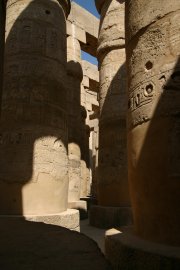 Not knowing where the convoy started we decided to just follow the main road south getting as far as we could until the police stopped us. This wasn't very far, about 20km outside Luxor there was a police roadblock with a familiar looking chap sitting waiting for something to happen - a South African called John who has been travelling the world on his motorbike and is heading slowly home; we'd met him first at the Crac des Chevaliers in Syria and here he was three weeks later having lost a bit of time waiting for some spare part in Cairo. He'd been there a couple of hours not knowing why he'd been stopped, but he didn't seem to care too much! When I explained about the convoy, all became clear to him, but he couldn't understand the logic either. He had tried protesting that he would have to ride in the dark if he waited for the convoy but they wouldn't budge. The roads are very dangerous and difficult at night because of animals in the road and invisible speed bumps but mainly because many vehicles drive without lights and you don't see them until you're really close behind. We have tried to avoid driving at night wherever possible but without too much success!
Not knowing where the convoy started we decided to just follow the main road south getting as far as we could until the police stopped us. This wasn't very far, about 20km outside Luxor there was a police roadblock with a familiar looking chap sitting waiting for something to happen - a South African called John who has been travelling the world on his motorbike and is heading slowly home; we'd met him first at the Crac des Chevaliers in Syria and here he was three weeks later having lost a bit of time waiting for some spare part in Cairo. He'd been there a couple of hours not knowing why he'd been stopped, but he didn't seem to care too much! When I explained about the convoy, all became clear to him, but he couldn't understand the logic either. He had tried protesting that he would have to ride in the dark if he waited for the convoy but they wouldn't budge. The roads are very dangerous and difficult at night because of animals in the road and invisible speed bumps but mainly because many vehicles drive without lights and you don't see them until you're really close behind. We have tried to avoid driving at night wherever possible but without too much success!
 The 3pm convoy was on time and we joined it as it passed where we'd got to about 20 minutes later. Unfortunately the police escort was a complete joke, beckoning us to overtake for some strange reason, and soon enough all the vehicles got spread out so much that we got lost in Edfu as we passed through and had to ask directions! But we finally arrived at Aswan and after looking for a campsite which was recommended in the guide book and discovering it had closed down some time ago, we decided to head into the centre and find some food. Just as we were passing the main square, a Land Cruiser approached - Alex and Maz were just entering town also looking for food. "Knew it was you," said Alex, "because you had your lights on!" They had just returned from Abu Simbel.
The 3pm convoy was on time and we joined it as it passed where we'd got to about 20 minutes later. Unfortunately the police escort was a complete joke, beckoning us to overtake for some strange reason, and soon enough all the vehicles got spread out so much that we got lost in Edfu as we passed through and had to ask directions! But we finally arrived at Aswan and after looking for a campsite which was recommended in the guide book and discovering it had closed down some time ago, we decided to head into the centre and find some food. Just as we were passing the main square, a Land Cruiser approached - Alex and Maz were just entering town also looking for food. "Knew it was you," said Alex, "because you had your lights on!" They had just returned from Abu Simbel.
We found some food (kebab, since you ask) and Alex and Maz decided to try to drive out of town and towards the coast, if the police would let them, and Elena and I found a hotel, not so much because we wanted the comfort of a hotel (the roof tent is very comfy!) but because we wanted someone to arrange touristy things for us... we wanted to go to Abu Simbel the next morning and having heard that the convoy was at 4am (!!) I didn't want to get up so early and drive the 300km each way. We thought that it would be fairly simple to join an organised trip from Aswan but with the tourist info place shut for the night, a hotel was the only way to organise it. Sure enough it was simple to organise so with alarms set for 3:00am (the hotel insisted on providing us breakfast at that ridiculous hour) we retired early.
| All content copyright � overland-underwater.com - please do not use without permission. |
